Limited Liability Company’s official owners, the business is listed as majority-owned Native American.
A Lickety Split spin-off has now formed on the Ute Mountain Ute reservation south of Blanding, coordinated by its director of education, Kelda Rogers. Stakeholders dream of similar franchises on reservations across the country. Increased volume could allow them to sell chocolate to such venues as the National Museum of the American Indian in Washington, D.C.
utah : lickety split chocolates
Getting out of poverty, Elaine argues, is a matter of acquiring skills and then assets.
By making chocolate, the children learn from start to finish what running a business means:
“This is Hubert, our VP of sales and marketing,” says Lickety Split Chocolates’ CEO
how to do the books, put a quality control system into place, cost a product and market it.
Andrew Dayish, of a ten-year-old boy wearing a “Grim Reaper” Halloween mask.
In order to get hired, children must exceed a 2.5 grade point average, which they must also
“I am not. I’m a dead guy!” retorts Hubert Dayish, before running off for another maintain if they wish to stay. But Elaine reckons the average G.P.A. for a Lickety Split piece of cake, a cape flapping in his wake.
employee is 3.0, and she’s seen grades go up as leadership skills increase.
All of Lickety Split’s owner-operators don corporate titles and Halloween While the Navajo basket chocolate lollipop—which uses pure butter and cocoa costumes, file paperwork and eat cake, equally comfortably.The fifteen children managing butter—is still the most popular Lickety Split product, the children have also developed the tiny chocolate factory at the edges of Blanding, Utah, are a boisterous mix of the rural truffles; caramel apples presented in pretty origami boxes; hogan, teepee, and Kokopelli-community’s Navajo, Mormon, Mexican, and Anglo populations.The chocolate shop is set shaped chocolates; chocolate-dipped strawberries and pretzels; painted pottery, and deeply within one of the nation’s largest and poorest counties, the only one in Utah with a jewelry.They have opened a retail store on Main Street with funds raised by hosting a “café”
Native American majority, where 30 percent of people live below the poverty line and less with live music, desserts for sale, and pint-sized waiters and waitresses. Each year they hold than one percent of the businesses are Native-owned. But Lickety Split’s children, a business retreat during which the Blanding and White Mesa branches of Lickety Split nicknamed in one article the “White Mesa Wonkas,” have sold nearly thirty thousand spend a few days together. Last year, before they traveled to the Oregon Coast, a local dollars worth of confections during their three years in business.
medicine man performed a ceremony to ensure the children’s safe return.
Tired and cheerful Elaine Borgen is the patient saint sustaining the project.
Having moved to Blanding as a VISTA volunteer after twenty years in the corporate world, she remembers kids like Andrew, Creedence Sampson, Tya Manygoats,Tiffany Billie, and a few others knocking at her door to ask for money for the movies.
“I can’t lend you all money,” she said,“but come back tomorrow, and we’ll try to figure out a way for you to make your own money.”
The next day’s brainstorming session led to the germination of the company’s flagship product, a chocolate lollipop decorated like a traditional Navajo basket. Over the All of Lickety Split’s owner-operators don
next four months, the children and Elaine made prototypes, evolved their technologies, and corporate titles and Halloween costumes, file
assigned roles: CEO, CFO, COO, president, vice president, and managers of the company’s paperwork and eat cake, equally
production, shipping and handling, computer, art, and sales and marketing departments.
comfortably.
The children meet four times a week: for after-school tutoring on Mondays and Wednesdays, and chocolate making on Fridays and Saturdays. Chocolate-making days end with a team meeting where they assess progress and discuss new schemes that have appeared on the “Chocolate Idea Board.”
Older children are paid by the hour and younger ones through a point system whose monetary value changes according to the company’s profits (much like stock options). Some employees earn upwards of seven hundred dollars a year. Many use the 44 : o u t s t a n d i n g y o u t h

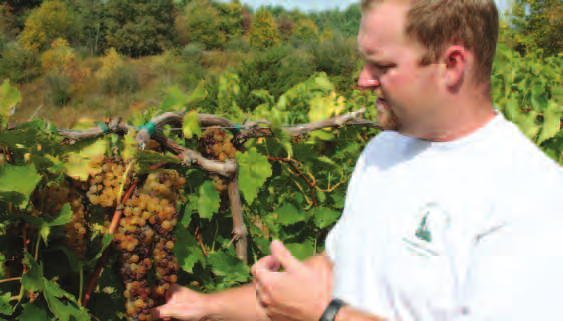
While she’s quick to laud the kids as the movers and shakers of Lickety Split, Elaine deserves much credit. She goes above and beyond, even offering breakfast at her From Mines to Wines
house before school every morning to neighboring children. She works tirelessly teaching business courses at the local college, chairing the San Juan County VISTA volunteers, and pairing rural residents with business opportunities through her own VISTA project—the Legacy Community Development Corporation. Since transportation can be a challenge, many of these jobs allow people to work from home, employed by call centers or a remote-site medical coding business.
In a county so big and remote it covers the
Any money made on top of her VISTA stipend (which turns out to be only 10
same space as Rhode Island, Connecticut,
virginia : david lawson
percent above the poverty line) is poured into Lickety Split. Once the children start turning and Massachusetts, with only one
16, Elaine hopes to help them set up Individual Development Accounts (IDAs), bank inhabitant for every two of its desolate,
accounts similar to a 401(k) that are matched three to one by the state. She recognizes rocky square miles, a group of children get
that as a business the company is less than sustainable, leaning heavily upon her labor. The together every week to alchemize raw
number of orders often exceeds the time the children have available to fill them, so Elaine materials into what may look like
ends up making some of the chocolates herself. But she does believe the skills that the chocolate—but is actually far more.
children are learning will allow them to start sustainable businesses of their own someday.
Neither Elaine nor the kids have gone unnoticed. Generous individuals have awarded each of the kids a used bicycle and a computer, although most of them lack Internet, and some even electricity, at home. Elaine was named this year’s Small Business Association’s Minority Champion of the Year. The children have traveled to national conferences and been recognized by Utah senators. Creedence even met President Bush and Andrew had breakfast at the White House with Elaine.
When asked about the ways their organization differs from more traditional companies, one employee pipes up:“Our waste is about 30 percent, which is higher than at other chocolate factories, but it’s hard for us to keep our hands off the chocolate!”
Indeed, a pint-sized Wonka sporting a pastry chef’s floppy hat sidles up to me repeatedly with shards of white chocolate melting in her palm. Elaine maintains that Lickety Split has more to do with education than chocolate, but the children disagree:“The best thing is definitely the chocolate.”
“And the people!” another pipes up.
In a no-alcohol, Mormon town where the intoxicants of choice are metham-phetamines and Listerine, set in a county so big and remote it covers the same space as Rhode Island, Connecticut, and Massachusetts, with only one inhabitant for every two of its desolate, rocky square miles, a group of children get together every week to Rolling a tiny fruit between his fingers, David Lawson looms over a row of grapes.
alchemize raw materials into what may look like chocolate—but is actually far more.
His tanned complexion is proof of the many hours he spends in the fields. Not so long ago, The phone rings, and Tya Manygoats picks up.
the land where David stands was barren ground—shredded by decades of coal mining. But
“Hello, Lickety Split Chocolate,” she says perkily, then, annoyed, to someone unlike most reclaimed mine land in Wise County, Virginia, David has slowly converted the in another room insolent enough to greet the same caller:“I already answered, okay?”
former wasteland into a prospering winery and vineyard.
Then, back to the caller:“What can I help you with today?”
MountainRose Vineyards is the product of a dream David has been developing since he was a young boy growing up in Wise, Virginia.The town of three thousand people 46 : o u t s t a n d i n g y o u t h
u n c o m m o n w i s d o m : 47
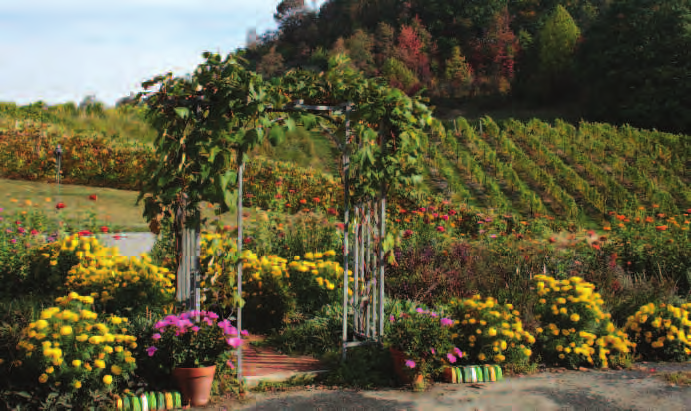
had been home to some of the country’s most lush apple orchards beginning in the 1930s, Suzanne, took an early retirement from the local school district before joining their son as until the incursion of mining in the 1960s. Now twenty-nine, David is determined to bring winemakers. Brandi, David’s wife, is doing her part too. She keeps her job as a physical back farming.
therapist to pay the bills, while Mia, the couple’s new baby, is sprouting into a seasoned His farming career began in fourth grade, when he and a classmate sought professional grape tester.
“I’m totally that person who knows what they
guidance from David’s grandmother. Relying on her childhood memories, they began The name MountainRose Vineyards has its own unique history that adds to David’s love and what they want to do, and made a
producing molasses and apple butter. By high school, David was growing produce and story.The MountainRose is a seventh generation, family heirloom rose that his ancestors job out of doing it.You’re only here once.You
even took part in creating the community farmers’ market. He developed an interest in passed down through his family. David plants one MountainRose bush, along with a few gotta follow your dream.”
winemaking, and by the time he graduated in 1997, David had planted his first commercial other varieties, at the beginning of each row of wine grapes. He has discovered that the acre of grape vines.
roses contract diseases before the grapes, and thus serve as an indicator that he stays After graduation, David enrolled at Virginia Tech. Over the next few years he would keenly aware of. Beyond their history and function, the roses add glorious splashes of color attend three different universities. But David’s education was in no way restricted by the that frame the endless rows of grape vines.
university walls. At Virginia Tech, he worked at a wine cellar where he was quickly promoted What sets David apart from some farmers in the area is his deep passion for the to assistant winemaker. David credits this six
future of agriculture in Wise County. He is a proud Appalachian, with a fond months of hands-on experience at the
respect for the mining history of the region.The theme of his winery is “Mines to winery for much of his success today. He’s
Wines.” David feels a responsibility “to honor some of what the mine land made like a walking vintner’s book, reading five
possible.” He knows that vineyards and wine tastings may be a new concept to separate wine periodicals each week. Along
his fellow Appalachians and is dedicated to reaching out to locals.With this in with the local library’s collection of
mind, MountainRose Vineyards wines are named after local coal seams. David agricultural books, innumerable wine and
tells of retired miners who come to the winery with their families and how their viticulture magazines helped lay the
faces light up when they see the “Dorchester” wine—because that was the seam foundation for MountainRose Vineyards.
they had worked in.
After completing his internship,
Ten years after planting his first acre of grapes, David now has a David returned to his hometown to start
sophisticated winery that he works constantly to improve. He grows eleven his winery. To prepare his land for grapes,
different grape varieties from which he produces nine wines.The winery is open he planted clover and tubers to replenish
six days a week and receives a constant flow of new visitors for the wine tastings, nutrients in the soil. Aside from the
as well as regular customers coming to buy a couple bottles of local flavor. David unique challenges inherent to growing
also sells his wine to local restaurants, and the vineyard hosts events throughout on reclaimed mine land, David explains
the year, such as dinners, performances, a quilt show and cooking classes. Most that it takes between five and eight years
recently, David’s dessert wine, Autumn Gold Vidal Blanc, was awarded Best in from the first planting until the wine is
Show at this year’s Virginia State Fair.
bottled and ready to be sold. During
Aside from the work he does on the vineyard, David continues to be those years, he raised and sold over four
active in the community. He currently serves as president of the local Farm thousand fall mums, annually, to generate
Bureau and explains that his primary goal is getting farmers back to Wise some farm income.
County. David concedes that unlike most Farm Bureaus, his does not have By 2004, David had his first harvest.
enough farmers to engage in much policy work. He wants to attract enough to He is quick to point out that the entire
the area to raise policy issues. David hopes that both by example and through project is family run.While he was the one
his work at the Farm Bureau, he will be able to inspire other young farmers to with the vision, his parents and wife
take a risk and follow their dreams.
enabled his passion to reach fruition.The
“I was the first to put a commercial winery here,” he adds.“I’m totally four worked together to build the winery
that person who knows what they love and what they want to do, and made a and plant all the vines. His parents, Ron and
job out of doing it.You’re only here once.You gotta follow your dream.”
48 : o u t s t a n d i n g y o u t h
u n c o m m o n w i s d o m : 49

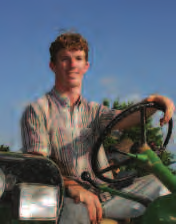

New Ideas, Old-Time Values
Rosanna’s passion is agritourism and educating others about sustainable farming. She first found interest in sharing her farm at an agritourism workshop sponsored by the state of Kansas. She then attended the North American Farmers’ Direct Marketing Association’s annual meeting in Texas, and came home energized to make her family’s farm an agritourism destination.
The agritourism activities on the farm have grown to include a “Day on the Farm,” where children come to see baby animals, help plant the year’s pumpkin field, see a sheep shearing demonstration, and learn about everyday farm life. Rosanna has kansas : bauman family
worked with the local chamber of commerce to market their farm in conjunction with the town’s “Corn Days” celebration.
Sixteen-year-old Kevin has his own flock of sixty grass-fed sheep that he is Down a winding country road in Garnett, Kansas stands the
raising on organic pastures and marketing for sale.
Bauman farm, where agriculture is truly a family affair. Along with their Pumpkins and ducks are the responsibility of the next Bauman, fifteen-year-old parents, six Bauman children, age nine to twenty-two, take active roles Steven. He is looking into the marketing opportunities for the meat and eggs from his in farming.
flock of ducks. This past year, Steven also applied and received a Kansas SARE Youth The family includes John and Yvonne, and their children,
Grant to study the effectiveness of using trap crops to keep squash bugs off organic Marvin, twenty-two, Rosanna, twenty, Kevin, sixteen, Steven, fifteen, Ivin, pumpkins. The two acres of pumpkins that he grew were sold to grocery stores and at twelve, and Joanna, nine. The Bauman’s bought this farm in 2001. The the fall events on the farm.
farm, which is always bustling with activity, lies past the Cedar Creek Ivin and Joanna, the youngest Baumans, are already planning their own Reservoir on the main road outside of Garnett. The Bauman’s first enterprises.“I want to live in the country and farm with horses!” exclaims Ivin. As of now, farming venture as a family was to raise pastured chickens and
he has an interest in modern production agriculture, while still utilizing historic farm livestock. Today, they market chickens, ducks, eggs, lamb, and beef to restaurants and grocery stores within one hundred miles of their home.
The Baumans sell about 7,000 broiler chickens each year and an
average of 350 dozen eggs a week.
In 2005, the family applied for a Sustainable Agriculture
Research and Education (SARE) grant through the U.S. Department of Agriculture. They wanted to study the possibilities of having different species of animals pastured in the same area. Their “Multi-Species Pasture Stacking” now takes place on forty acres of pasture with permanent fencing around the perimeter. In the interior of the pasture, large paddocks are marked off by hot wire. With the “pasture stacking” project, the family increased their broiler chicken’s weight by 50 percent.
Rosanna, the eldest of the girls, explains that the weight increase was due in large part to the addition of a new water system.“Beyond the benefits on the farming operation, the project had a positive social impact on us kids,”
explains Rosanna.“It has led each of us to take steps towards farming sustainably.”
Marvin has perfected his crop rotation capabilities and established his own forty acres of certified organic cropland. Newly married, Marvin and his wife Audrey live only a few miles from the family farm. Profits from his acreage have been reinvested in equipment and machinery to sustain the farm.
50 : o u t s t a n d i n g y o u t h
u n c o m m o n w i s d o m : 51
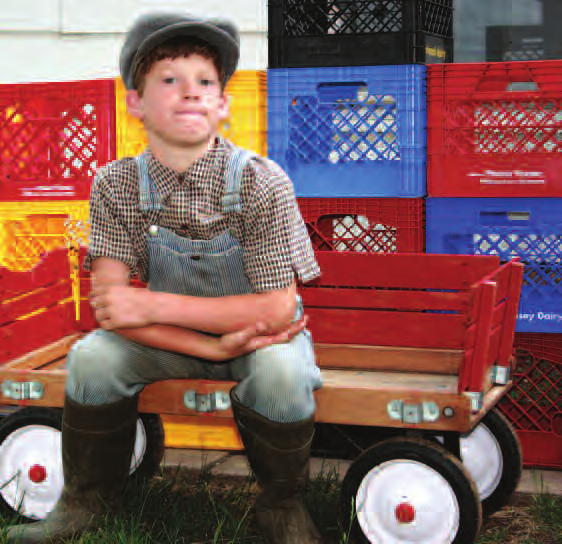
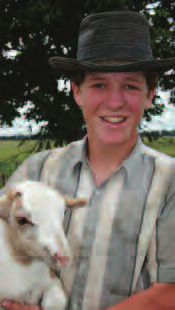
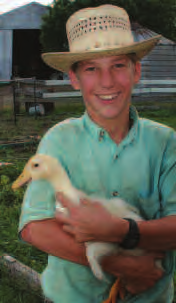
implements and heritage breeds. When Ivin isn’t riding his pony, he can be found helping his older siblings with their farm projects.
“I want to raise cats,” declares Joanna, the unofficial director of public relations for the farm. Joanna’s youthful smile and exuberance for sharing her family’s farm draws in many visitors.
The Bauman children get to know their customers, and the customers start to associate their faces with local agriculture. Belonging to the Old German Baptist Brethren, the Bauman’s follow the agricultural family traditions of years’ past, promoting faith, togetherness, community, and love of the land. Despite their old-time values, they take advantage of modern research and programs. They are active in the Kansas-sponsored “Simply Kansas” promotional campaign, and they work with a network of other entrepreneurial farm families.
It is through such networking that the Bauman family identified the need for more chicken processing facilities in the state of Kansas. In 2007, they opened a Kansas-certified chicken processing plant on their farm, becoming the first farmers in the state to process their own birds. Many local producers now bring their chickens to the plant for processing and the Baumans estimate they will process fifteen thousand birds per year.
The Baumans are aiming to make the plant the most sustainable chicken processing facility in the state—and perhaps the nation—by composting 100 percent of all waste and offal. Most importantly, they have slowly made progress convincing the inspectors to allow them to use less toxic chemicals. Currently, all industrially-processed chickens are bathed in Clorox before, during, and after processing. After endless cajoling, the Baumans are getting approval to use an organic-based sanitizer and another that is like hydrogen peroxide.“We are making progress little bit by little bit,” says Rosanna.
The Baumans recently helped start a local farmers’ market in downtown Garnett, that has exceeded their best expectations. They enjoy educating their neighbors and customers about the kind of sustainable practices they use—and just plain enjoy the hometown social interaction that the market provides.
John Bauman says about his children,“I just wanted to have a place where the kids could learn and find their own interests. Once they find their interest area, they can then build on that for their future.”
The Bauman children’s self-motivated work ethic is not regularly seen in today’s world. Their commitment to their family, community, and customer interaction has drawn the attention of many in the local foods movement.
“Our greatest sharing times come when we give farm tours to families, retirees, and school groups,” says Rosanna.“They experience a real working family farm that practices sustainable farming methods. We are always certain to educate them how we farm differently than others, and how it benefits them.”
52 : o u t s t a n d i n g y o u t h
u n c o m m o n w i s d o m : 53
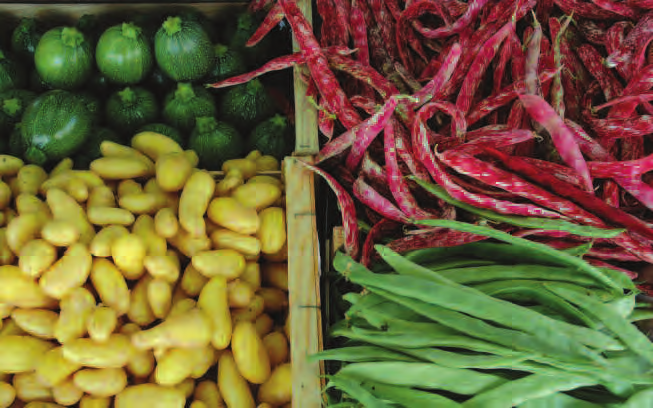
Thinking beyond his cold-weather production system, Walter and his partner, Kimberly Griffin, have developed a novel concept in marketing farm-fresh foods—
From Greenhouse to Grocery
owning the grocery store where local foods are sold. This approach provides them a ready market for anything and everything they can produce on their farm. In addition to their own produce, the couple stocks a full line of fruits and vegetables, meats, dairy products, eggs, jams, jellies, grains, and many other value-added products. They also sell artisan crafts and personal care products.
“We decided to go for it, and we just needed a name,” explains Walter.“So we decided to call it ’The Root Cellar’ to show our roots in the farming community. A missouri :
generation ago, people were eating out of their root cellars for much of the year. That’s kimberly griffin & walker claridge
where you got your potatoes and apples, your canned goods, your winter eats.”
Since opening in the summer of 2001, the Root Cellar has purchased goods As mornings become cool and October frosts grow near, many mid-Missouri from more than 200 farmers. Although they prefer to purchase organic and vegetable farmers race to clear their fields of the few remaining tomatoes, eggplant, sustainable products, The Root Cellar’s “golden rule” is that, if at all possible, their okra, and green beans. The local farmers’ market bustles with customers looking for that products, from basil to bacon to bison burgers, come from the bounty of Missouri’s last taste of summer. Most farmers are happy to oblige, wrapping up the season and varied farm and forest landscape.
looking forward to a slower pace after months of planting, weeding, and harvesting.
“When we say local, that’s what we mean,” says Walter.“Sometimes we’ve got But on a small, ridge-top farm overlooking Cedar Creek in rural Callaway to stretch it slightly. I mean coffee, for instance. We’ve got locally-roasted coffee. That’s County, Walker Claridge’s harvest season is just picking up steam. In the warmth of two greenhouses, this thirty-two-year-old entrepreneur has developed an innovative
“My strategy has been to produce
food production and marketing system by focusing on the colder months. He grows a something when the farmers’ market is
wide variety of lettuce and greens, chard, arugula, and fresh-cut herbs from October gearing down for winter. People still want
through May.
that good farmers’ market food in
“My strategy has been to produce something when the farmers’ market is November, but there’s not much available.”
gearing down for winter,” he says.“People still want that good farmers’ market food in November, but there’s not much available.”
Dubbed the “greenhouse within a greenhouse” approach, Walter’s system produces his crop with almost no energy costs. He heats only a small corner of one of the greenhouses, where his germination and seeding trays spend a few weeks before being transplanted into the fertile soils of his raised beds.
“This is all about solar energy,” Walter explains.“If you can collect the sun’s rays and heat the ground up without allowing that warm air to escape, you’re three-quarters of the way there. When it gets closer to zero, we cover our beds with another layer of plastic to protect the plants a little more.”
Walter maintains that his crops can withstand freezing temperatures as long as they’re not subject to the wintry winds and moisture changes outside the greenhouses.
This approach provides the ultimate niche for Walter.
“Just think about Thanksgiving and Christmas,” Walter suggests,“probably the two biggest food holidays we’ve got. What are people going to do for their Thanksgiving salad? That demand for fresh and local doesn’t go away during the off-season—but the supply is almost non-existent.”
54 : o u t s t a n d i n g y o u t h

the best we can do on that one. How could you try to have a grocery store and not sell coffee?”
Simple Materials, Grand Designs
The store is able to offer a wide variety of products, everything from Missouri-grown rice to fresh trout from spring-fed Ozark creeks and ponds. They even produce their own line of gourmet salsa, marinara, and other value-added sauces.
“People come in here for the first time, and they’re usually looking for some specialty goods,” says Walter.“They’re surprised they can pretty much get everything they need right here in Missouri. We’ve got almost all of your shopping list right here on our shelves.”
vermont : ben graham
If this all sounds like a lot of work, it is. Walter and Kimberly spend countless hours managing both the farm and the grocery store.
“We’ve tried it all,” says Walter.“I mean, we had the breakfast and lunch café thing going for a while. We’ve done deli foods and sandwiches. We’ve done a lot of catering jobs.”
Now, with their son, Lushen, nearing the age of two, the couple is revamping The Root Cellar with a streamlined approach to achieving their goals. They recently completed a move from a larger location with kitchen facilities to a smaller storefront in a high-traffic area. The new location is in the heart of downtown Columbia, a vibrant Has it been easy? “No way!” says Walter.“But
community of specialty shops, restaurants, and other retail establishments. In addition we’ve made a decent living and we’re doing
to reaching more shoppers, the new Root Cellar site has cut expenses due to reduced what we love. We get to be our own boss. I
rent and utility rates.
don’t know how you can put a dollar value
“We’re in good shape in the new location,” Kimberly explains.“Our customer on that, but it’s worth every penny.”
base is well-est














